Unit1Where did you go on vacation Section A 2a-2d 课件+音频(共27张PPT) 人教版英语八年级上册
文档属性
| 名称 | Unit1Where did you go on vacation Section A 2a-2d 课件+音频(共27张PPT) 人教版英语八年级上册 |  | |
| 格式 | pptx | ||
| 文件大小 | 4.0MB | ||
| 资源类型 | 教案 | ||
| 版本资源 | 人教新目标(Go for it)版 | ||
| 科目 | 英语 | ||
| 更新时间 | 2024-07-16 20:44:58 | ||
图片预览

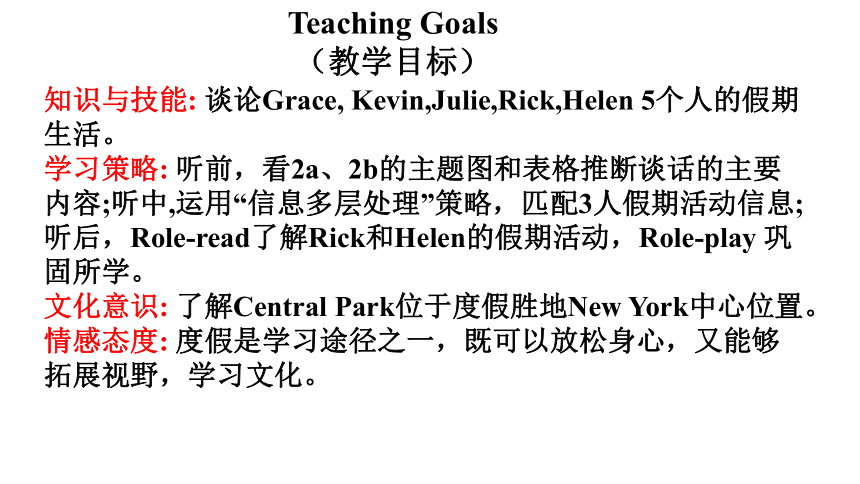
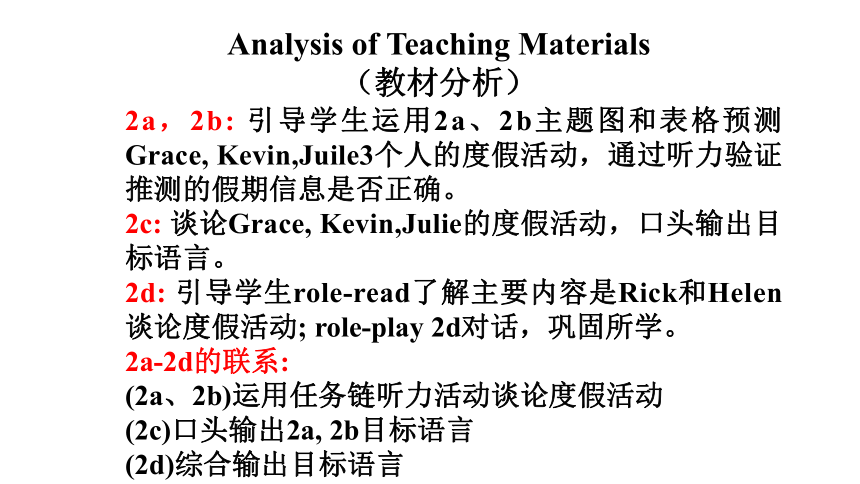
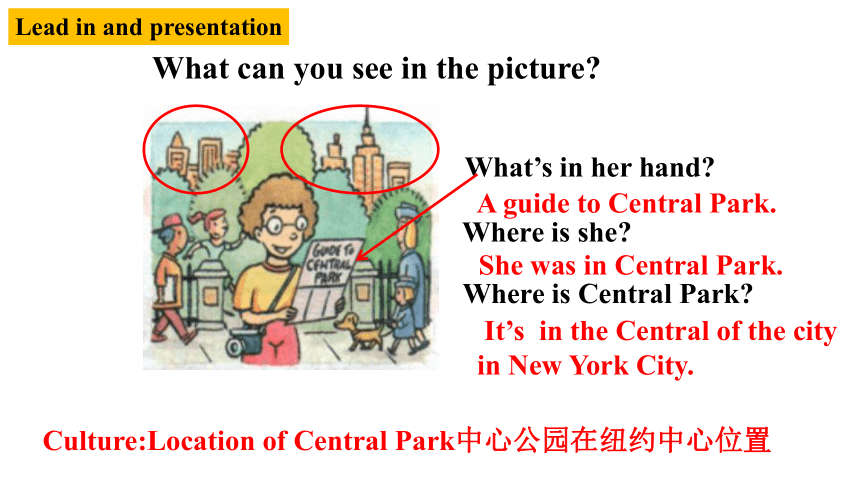
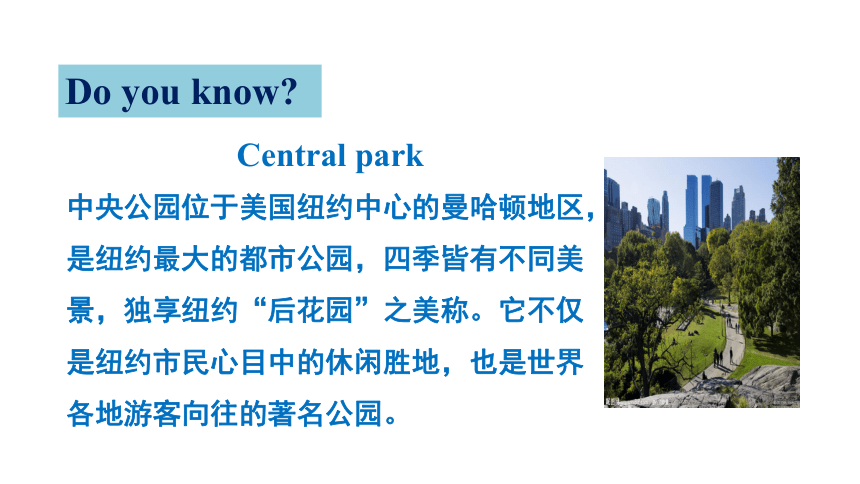


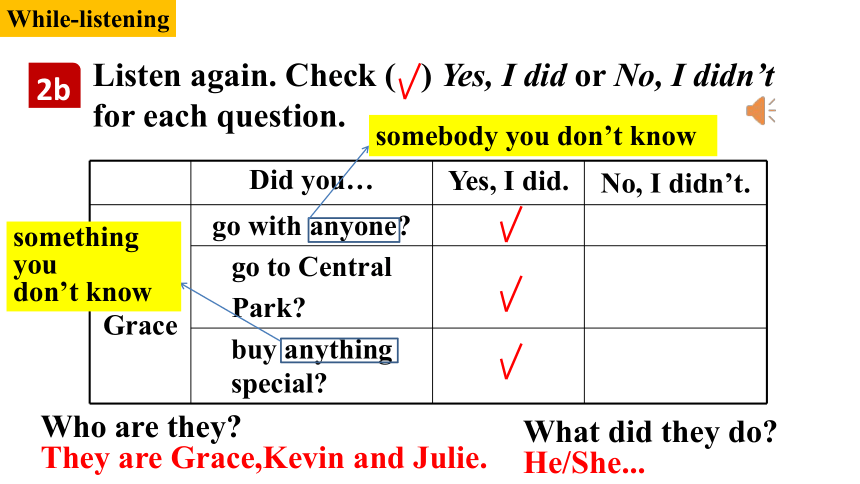
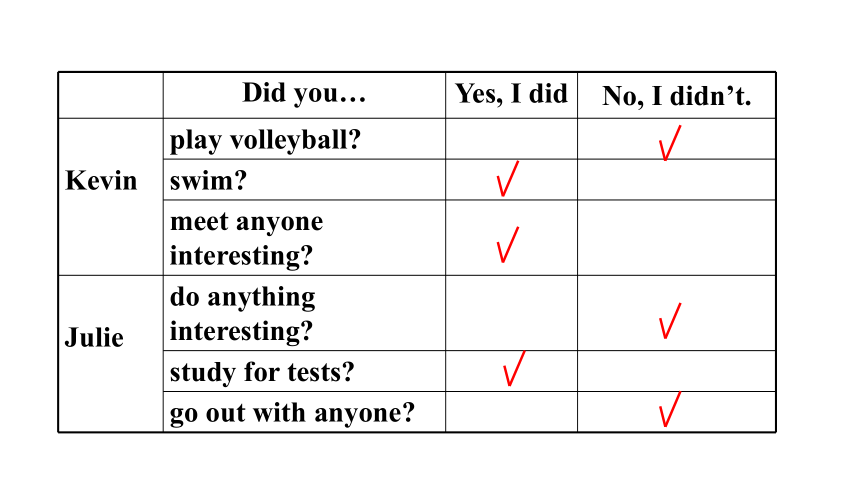
文档简介
(共27张PPT)
Section A 2a-2d
Unit 1 Where did you go on vacation
Teaching Goals
(教学目标)
知识与技能: 谈论Grace, Kevin,Julie,Rick,Helen 5个人的假期生活。
学习策略: 听前,看2a、2b的主题图和表格推断谈话的主要内容;听中,运用“信息多层处理”策略,匹配3人假期活动信息;听后,Role-read了解Rick和Helen的假期活动,Role-play 巩固所学。
文化意识: 了解Central Park位于度假胜地New York中心位置。
情感态度: 度假是学习途径之一,既可以放松身心,又能够拓展视野,学习文化。
Analysis of Teaching Materials
(教材分析)
2a,2b: 引导学生运用2a、2b主题图和表格预测Grace, Kevin,Juile3个人的度假活动,通过听力验证推测的假期信息是否正确。
2c: 谈论Grace, Kevin,Julie的度假活动,口头输出目标语言。
2d: 引导学生role-read了解主要内容是Rick和Helen谈论度假活动; role-play 2d对话,巩固所学。
2a-2d的联系:
(2a、2b)运用任务链听力活动谈论度假活动
(2c)口头输出2a, 2b目标语言
(2d)综合输出目标语言
What can you see in the picture
What’s in her hand
A guide to Central Park.
Where is she
She was in Central Park.
Where is Central Park
It’s in the Central of the city
in New York City.
Culture:Location of Central Park中心公园在纽约中心位置
Lead in and presentation
Central park
中央公园位于美国纽约中心的曼哈顿地区,
是纽约最大的都市公园,四季皆有不同美
景,独享纽约“后花园”之美称。它不仅
是纽约市民心目中的休闲胜地,也是世界
各地游客向往的著名公园。
Do you know
2a
Listen. Where did the people go on vacation Complete the chart.
People places
Grace
Kevin
Julie
Tip:根据“2b表格的文字内容”进行预填
Pre-listening
Listen. Where did the people go on vacation Complete the chart.
People places
Grace
Kevin
Julie
New York City
the beach
at home
2a
While-listening
Listen again. Check ( ) Yes, I did or No, I didn’t for each question.
Did you… Yes, I did. No, I didn’t.
Grace go with anyone
go to Central Park
buy anything special
2b
Who are they
They are Grace,Kevin and Julie.
What did they do
He/She...
somebody you don’t know
something you
don’t know
While-listening
Did you… Yes, I did No, I didn’t.
Kevin play volleyball
swim
meet anyone interesting
Julie do anything interesting
study for tests
go out with anyone
A: Grace, where did you go on vacation
B: I went to New York City.
A: Oh, really Did you go with anyone
B: Yes, I went with my mother.
Role-play conversations between Grace, Kevin and Julie.
2c
Post-listening
Q1 : What can you see
Q2 : Where is it
I can see Huangguoshu Waterfall.
It is in Guizhou.
Huangguoshu Waterfall
Pre-read
1.Who are talking to
each other
2.What are they talking about
3.Did they go anywhere interesting with anyone
4.Did Helen take any photos
5.Did Rick do anything interesting during the vacation
6.How was Rick’s vacation
Rick’s vacation is just so so.
Role-read
Do you have any questions
Can you tell me the meaning of “Long time no see.”
Are they having a face to face talking And why
Tip:About “Long time no see.”
这是习惯性被西方接纳的中文式问候,我们在学习中要遵循英语学习的原则,不能随意创造中文式英文。
Role-read
When you role-read:
You need imitate.
You need feelings.
(读的技巧:模仿和情感)
Role-play
When you role-play:
You need imitate.
You need feelings.
(读的技巧:模仿和情感)
2d
Which vacation do you like
And why
I like Rick’s vacation better.
Because Rick read a lot during
the vacation.
I like Helen’s vacation better.
Because Helen went to
beautiful places on vacation.
Feeling:
在假期中,我们可以读万
卷书,也可以行万里路。
—Where did you go on vacation
— I went to New York City.
— Did you go out with anyone
— No. No one was here. Everyone was on vacation.
— Did you buy anything special
— Yes, I bought something for my father.
— No, I bought nothing.
Summary
1. —Did you go to Central Park 你去中心公园了吗?
— Yes, I did. 是的,去了。
这是一个一般疑问句,由助动词提问,回答也用助
动词。由于询问的是发生在过去的事,所以助动词用
过去式did。一般过去时的一般疑问句的句子结构:
Did+主语+动词原形+其它
Language Points
回答: Yes, 主+did. / No, 主+didn’t.
在过去时态中, 无论主语是第几人称,是单数
还是复数,助动词一律用 did。
e.g. —Did you/he/she/they go to the park last night
—Yes, I/he/she/they did.
—No, I/he/she/they didn’t.
2. Did you buy anything special
在英语中,anything, something, nothing 和everything是用于指代事物的复合不定代词,与之相对应的复合不定代词 anyone, someone, no one 和everyone ( anybody, somebody, nobody 和 everybody) 用于指人。
与形容词连用时, 形容词必须放在复合不定代词之后,语法上称作“后置”。
e.g. something important—— 重要的事
I can see someone new in your group.
我看见你们小组里有新人。
There’s nothing interesting in the news today.
今天的新闻里没有什么有趣的新闻。
3. I was on vacation last month.
be on vacation 译为 “在度假”,强调状态。
而 go to vacation, “去度假”,强调动作。
我们应该如何区分英语中强调动作和状态的词语:
1)一般来说,单独的动词/短语一般强调动作;而“be + 分词/形容词”则只表状态。如marry sb.和get married to sb.表动作,而be married to sb.表状态。
2)如果动词是延续性动词,则一般它既可表示
动作, 也可以表示状态。
e.g. live/stay/work…
3)如果是单独的瞬间性动词,则它只表示动作。
e.g. get up/put on/begin…
4. We took quite a few photos there.
此句中 quite a few 是一个整体结构,表示“相当多”, 修饰可数名词,不能与a few(少数几个) 混淆。
比较下面例句中quite a few 和a few的区别:
e.g. There are only a few books on the table, but I still have quite a few in the bookcase.
虽然桌上只有几本书,但我的书柜里还有很多书。
quite a few 相当多的;不少的 相当于many,修饰
可数名词复数。
quite a little 许多的, 相当多的 相当于much,修饰
不可数名词。
quite a few与quite a little
5. Did you buy anything special
复合不定代词分为:
指物:anything, something, nothing, everything
指人:anyone, someone, no one, everyone/ anybody, somebody, nobody, everybody
“后置”:复合不定代词 + adj.
e.g. I can see someone new in your group.
复合不定代词
adj.
+
模仿2d写对话,谈论假期经历。
Homework
Section A 2a-2d
Unit 1 Where did you go on vacation
Teaching Goals
(教学目标)
知识与技能: 谈论Grace, Kevin,Julie,Rick,Helen 5个人的假期生活。
学习策略: 听前,看2a、2b的主题图和表格推断谈话的主要内容;听中,运用“信息多层处理”策略,匹配3人假期活动信息;听后,Role-read了解Rick和Helen的假期活动,Role-play 巩固所学。
文化意识: 了解Central Park位于度假胜地New York中心位置。
情感态度: 度假是学习途径之一,既可以放松身心,又能够拓展视野,学习文化。
Analysis of Teaching Materials
(教材分析)
2a,2b: 引导学生运用2a、2b主题图和表格预测Grace, Kevin,Juile3个人的度假活动,通过听力验证推测的假期信息是否正确。
2c: 谈论Grace, Kevin,Julie的度假活动,口头输出目标语言。
2d: 引导学生role-read了解主要内容是Rick和Helen谈论度假活动; role-play 2d对话,巩固所学。
2a-2d的联系:
(2a、2b)运用任务链听力活动谈论度假活动
(2c)口头输出2a, 2b目标语言
(2d)综合输出目标语言
What can you see in the picture
What’s in her hand
A guide to Central Park.
Where is she
She was in Central Park.
Where is Central Park
It’s in the Central of the city
in New York City.
Culture:Location of Central Park中心公园在纽约中心位置
Lead in and presentation
Central park
中央公园位于美国纽约中心的曼哈顿地区,
是纽约最大的都市公园,四季皆有不同美
景,独享纽约“后花园”之美称。它不仅
是纽约市民心目中的休闲胜地,也是世界
各地游客向往的著名公园。
Do you know
2a
Listen. Where did the people go on vacation Complete the chart.
People places
Grace
Kevin
Julie
Tip:根据“2b表格的文字内容”进行预填
Pre-listening
Listen. Where did the people go on vacation Complete the chart.
People places
Grace
Kevin
Julie
New York City
the beach
at home
2a
While-listening
Listen again. Check ( ) Yes, I did or No, I didn’t for each question.
Did you… Yes, I did. No, I didn’t.
Grace go with anyone
go to Central Park
buy anything special
2b
Who are they
They are Grace,Kevin and Julie.
What did they do
He/She...
somebody you don’t know
something you
don’t know
While-listening
Did you… Yes, I did No, I didn’t.
Kevin play volleyball
swim
meet anyone interesting
Julie do anything interesting
study for tests
go out with anyone
A: Grace, where did you go on vacation
B: I went to New York City.
A: Oh, really Did you go with anyone
B: Yes, I went with my mother.
Role-play conversations between Grace, Kevin and Julie.
2c
Post-listening
Q1 : What can you see
Q2 : Where is it
I can see Huangguoshu Waterfall.
It is in Guizhou.
Huangguoshu Waterfall
Pre-read
1.Who are talking to
each other
2.What are they talking about
3.Did they go anywhere interesting with anyone
4.Did Helen take any photos
5.Did Rick do anything interesting during the vacation
6.How was Rick’s vacation
Rick’s vacation is just so so.
Role-read
Do you have any questions
Can you tell me the meaning of “Long time no see.”
Are they having a face to face talking And why
Tip:About “Long time no see.”
这是习惯性被西方接纳的中文式问候,我们在学习中要遵循英语学习的原则,不能随意创造中文式英文。
Role-read
When you role-read:
You need imitate.
You need feelings.
(读的技巧:模仿和情感)
Role-play
When you role-play:
You need imitate.
You need feelings.
(读的技巧:模仿和情感)
2d
Which vacation do you like
And why
I like Rick’s vacation better.
Because Rick read a lot during
the vacation.
I like Helen’s vacation better.
Because Helen went to
beautiful places on vacation.
Feeling:
在假期中,我们可以读万
卷书,也可以行万里路。
—Where did you go on vacation
— I went to New York City.
— Did you go out with anyone
— No. No one was here. Everyone was on vacation.
— Did you buy anything special
— Yes, I bought something for my father.
— No, I bought nothing.
Summary
1. —Did you go to Central Park 你去中心公园了吗?
— Yes, I did. 是的,去了。
这是一个一般疑问句,由助动词提问,回答也用助
动词。由于询问的是发生在过去的事,所以助动词用
过去式did。一般过去时的一般疑问句的句子结构:
Did+主语+动词原形+其它
Language Points
回答: Yes, 主+did. / No, 主+didn’t.
在过去时态中, 无论主语是第几人称,是单数
还是复数,助动词一律用 did。
e.g. —Did you/he/she/they go to the park last night
—Yes, I/he/she/they did.
—No, I/he/she/they didn’t.
2. Did you buy anything special
在英语中,anything, something, nothing 和everything是用于指代事物的复合不定代词,与之相对应的复合不定代词 anyone, someone, no one 和everyone ( anybody, somebody, nobody 和 everybody) 用于指人。
与形容词连用时, 形容词必须放在复合不定代词之后,语法上称作“后置”。
e.g. something important—— 重要的事
I can see someone new in your group.
我看见你们小组里有新人。
There’s nothing interesting in the news today.
今天的新闻里没有什么有趣的新闻。
3. I was on vacation last month.
be on vacation 译为 “在度假”,强调状态。
而 go to vacation, “去度假”,强调动作。
我们应该如何区分英语中强调动作和状态的词语:
1)一般来说,单独的动词/短语一般强调动作;而“be + 分词/形容词”则只表状态。如marry sb.和get married to sb.表动作,而be married to sb.表状态。
2)如果动词是延续性动词,则一般它既可表示
动作, 也可以表示状态。
e.g. live/stay/work…
3)如果是单独的瞬间性动词,则它只表示动作。
e.g. get up/put on/begin…
4. We took quite a few photos there.
此句中 quite a few 是一个整体结构,表示“相当多”, 修饰可数名词,不能与a few(少数几个) 混淆。
比较下面例句中quite a few 和a few的区别:
e.g. There are only a few books on the table, but I still have quite a few in the bookcase.
虽然桌上只有几本书,但我的书柜里还有很多书。
quite a few 相当多的;不少的 相当于many,修饰
可数名词复数。
quite a little 许多的, 相当多的 相当于much,修饰
不可数名词。
quite a few与quite a little
5. Did you buy anything special
复合不定代词分为:
指物:anything, something, nothing, everything
指人:anyone, someone, no one, everyone/ anybody, somebody, nobody, everybody
“后置”:复合不定代词 + adj.
e.g. I can see someone new in your group.
复合不定代词
adj.
+
模仿2d写对话,谈论假期经历。
Homework
同课章节目录
- Unit 1 Where did you go on vacation?
- Section A
- Section B
- Unit 2 How often do you exercise?
- Section A
- Section B
- Unit 3 I'm more outgoing than my sister.
- Section A
- Section B
- Unit 4 What's the best movie theater?
- Section A
- Section B
- Unit 5 Do you want to watch a game show?
- Section A
- Section B
- Unit 6 I'm going to study computer science.
- Section A
- Section B
- Unit 7 Will people have robots?
- Section A
- Section B
- Unit 8 How do you make a banana milk shake?
- Section A
- Section B
- Unit 9 Can you come to my party?
- Section A
- Section B
- Unit 10 If you go to the party, you'll have a grea
- Section A
- Section B
